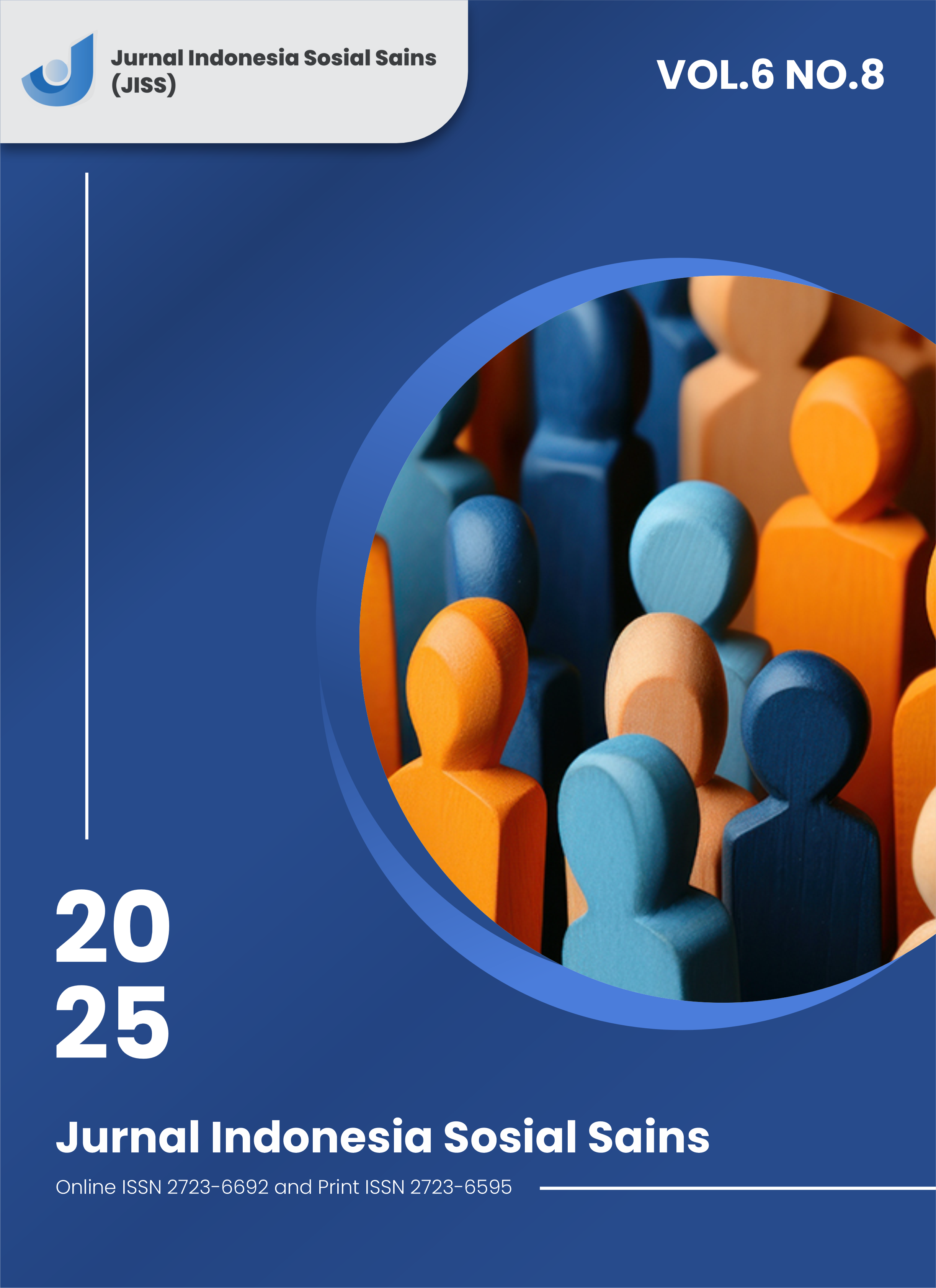Indigenous People Carrying Capacity; Consciousness of Protecting Nature
DOI:
https://doi.org/10.59141/jiss.v6i8.1842Keywords:
Carrying capacity, Morowali Nature Reserve, Protecting Nature, Wana tribeAbstract
The historical relationship between indigenous communities and their environment exemplifies sustainable coexistence, yet this balance is increasingly threatened by population growth and environmental degradation. This study examines the carrying capacity of the Wana tribe’s land in the Morowali Nature Reserve, Central Sulawesi, Indonesia, to assess its ability to support current and future populations while preserving ecological integrity. Using a mixed-methods approach, we combined geospatial analysis (ArcGIS) with ethnographic data to evaluate habitable land areas, accounting for slope constraints (0–15%) and the tribe’s customary land-use practices. Results revealed that the Wana tribe currently occupies only 955.3 hectares of the 4,660-hectare reserve, with a per-capita allocation of 2.07 hectares—five times the WHO minimum standard. However, projections indicate that the carrying capacity will be exceeded if the population reaches 2,274 individuals, risking resource depletion and ecosystem disruption. The study highlights the Wana’s sustainable practices, such as fallow periods and spiritual land protections, as vital to maintaining this equilibrium. These findings underscore the urgency of integrating indigenous knowledge into conservation policies to safeguard both cultural and environmental sustainability. By quantifying carrying capacity in a protected indigenous area, this research provides a replicable framework for similar contexts and advocates for policy support to mitigate future risks.
References
Boiral, O., Heras-Saizarbitoria, I., & Brotherton, M. C. (2020). Improving environmental management through indigenous peoples' involvement. Environmental Science and Policy, 103, 10-20. https://doi.org/10.1016/j.envsci.2019.10.006
Borrini-Feyerabend, G., Kothari, A., & Oviedo, G. (2004). Indigenous and local communities and protected areas: Towards equity and enhanced conservation. IUCN.
Bubandt, N. (2004). Towards a new politics of tradition? Decentralisation, conflict, and adat in Eastern Indonesia. Antropologi Indonesia Special.
Chapman, E. J., & Byron, C. J. (2018). The flexible application of carrying capacity in ecology. Global Ecology and Conservation, 13, e00365. https://doi.org/10.1016/j.gecco.2017.e00365
Colding, J., & Folke, C. (2001). Social taboos: "Invisible" systems of local resource management and biological conservation. Ecological Applications, 11(2), 584-600.
Dellasala, D. A. (2017). Global change. In Encyclopedia of the Anthropocene (Vol. 1-5, pp. 347-349). Elsevier. https://doi.org/10.1016/B978-0-12-809665-9.05355-6
Global Footprint Network. (2019). National footprint and biocapacity accounts 2019. Global Footprint Network.
Grumblies, A. T. (2013). Adat and indigeneity in Indonesia. Göttingen University Press.
Henley, D., & Davidson, J. S. (2008). In the name of adat: Regional perspectives on reform, tradition, and democracy in Indonesia. Modern Asian Studies, 42(4), 815-852.
Jayachandran, S., De Laat, J., Lambin, E. F., Stanton, C. Y., Audy, R., & Thomas, N. E. (2017). Cash for carbon: A randomized trial of payments for ecosystem services to reduce deforestation. Science, 357(6348), 267-273.
Loch, T. K., & Riechers, M. (2021). Integrating indigenous and local knowledge in management and research on coastal ecosystems in the Global South: A literature review. Ocean and Coastal Management, 212, 105821. https://doi.org/10.1016/j.ocecoaman.2021.105821
Ma, B. (2017). Literature review on land carrying capacity of the coordinated development of population, resources, environment and economy. AIP Conference Proceedings, 1890, 040003. https://doi.org/10.1063/1.5005308
Massey, A., Suich, H., & Child, B. (2011). An introduction to community-based natural resource management. WWF.
Midler, E., Pascual, U., Drucker, A. G., Narloch, U., & Soto, J. L. (2015). Unraveling the effects of payments for ecosystem services on motivations for collective action. Ecological Economics, 120, 394-405. https://doi.org/10.1016/j.ecolecon.2015.04.006
Pagiola, S., Honey-Rosés, J., & Freire-González, J. (2016). Evaluation of the permanence of land use change induced by payments for environmental services in Quindío, Colombia. PLoS ONE, 11(3), e0147829. https://doi.org/10.1371/journal.pone.0147829
Pham, V. T., & Roongtawanreongsri, S. (2022). Perceptions of indigenous people as service providers on payments for forest environmental services in the Central Highlands of Vietnam. Trees, Forests and People, 8, 100279. https://doi.org/10.1016/j.tfp.2022.100279
Poudyal, B. H., Maraseni, T., Cockfield, G., & Bhattarai, B. (2020). Recognition of historical contribution of indigenous peoples and local communities through benefit sharing plans (BSPs) in REDD+. Environmental Science and Policy, 106, 111-114. https://doi.org/10.1016/j.envsci.2020.01.022
Regassa Debelo, A., Legesse, A., Milstein, T., & Orkaydo, O. O. (2017). "Tree is life": The rising of dualism and the declining of mutualism among the Gedeo of Southern Ethiopia. Frontiers in Communication, 2, 7. https://doi.org/10.3389/fcomm.2017.00007
Rodrigue-Allouche, S. (2015). Conservation and indigenous peoples: The adoption of the ecological noble savage discourse and its political consequences. Environmental Politics, 24(3), 421-439.
Stan, A. B., Fulé, P. Z., & Hunter, M. (2022). Reduced forest vulnerability due to management on the Hualapai Nation. Trees, Forests and People, 10, 100325. https://doi.org/10.1016/j.tfp.2022.100325
Świąder, M., Szewrański, S., & Kazak, J. K. (2020). Environmental carrying capacity assessment the policy instrument and tool for sustainable spatial management. Frontiers in Environmental Science, 8, 579838. https://doi.org/10.3389/fenvs.2020.579838
Tran, T. C., Ban, N. C., & Bhattacharyya, J. (2020). A review of successes, challenges, and lessons from Indigenous protected and conserved areas. Biological Conservation, 241, 108271. https://doi.org/10.1016/j.biocon.2019.108271
Vanella, P. (2020). A probabilistic approach for measuring the robustness of demographic forecasts. Genus, 76(1), 1-28.
Vanella, P., & Deschermeier, P. (2020). A probabilistic cohort-component model for population forecasting—the case of Germany. Journal of Population Ageing, 13, 513-545.
Downloads
Published
How to Cite
Issue
Section
License
Copyright (c) 2025 Ahmad Sopian Pamungkas

This work is licensed under a Creative Commons Attribution-ShareAlike 4.0 International License.
Authors who publish with this journal agree to the following terms:
- Authors retain copyright and grant the journal right of first publication with the work simultaneously licensed under a Creative Commons Attribution-ShareAlike 4.0 International. that allows others to share the work with an acknowledgement of the work's authorship and initial publication in this journal.
- Authors are able to enter into separate, additional contractual arrangements for the non-exclusive distribution of the journal's published version of the work (e.g., post it to an institutional repository or publish it in a book), with an acknowledgement of its initial publication in this journal.
- Authors are permitted and encouraged to post their work online (e.g., in institutional repositories or on their website) prior to and during the submission process, as it can lead to productive exchanges, as well as earlier and greater citation of published work.












